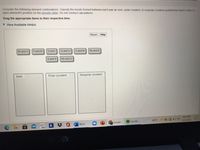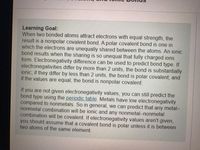
Chemistry
10th Edition
ISBN: 9781305957404
Author: Steven S. Zumdahl, Susan A. Zumdahl, Donald J. DeCoste
Publisher: Cengage Learning
expand_more
expand_more
format_list_bulleted
Concept explainers
Question

Transcribed Image Text:Consider the following element combinations. Classify the bonds formed between each pair as ionic, polar covalent, or nonpolar covalent qualitatively based solely on
each element's position on the periodic table. Do not conduct calculations.
Drag the appropriate items to their respective bins.
> View Available Hint(s)
Reset
Help
Sr and O
P and Br
S and I
Cl and CI
O and Br
Rb and N
S and S
Mn and CI
lonic
Polar covalent
Nonpolar covalent
6:03 PM
Google...
Spotify .
80°F
11/7/2021
B.
Word

Transcribed Image Text:Learning Goal:
When two bonded atoms attract electrons with equal strength, the
result is a nonpolar covalent bond. A polar covalent bond is one in
which the electrons are unequally shared between the atoms. An ionic
bond results when the sharing is so unequal that fully charged ions
form. Electronegativity difference can be used to predict bond type. If
electronegativities differ by more than 2 units, the bond is substantially
ionic; if they differ by less than 2 units, the bond is polar covalent; and
if the values are equal, the bond is nonpolar covalent.
If you are not given electronegativity values, you can still predict the
bond type using the periodic table. Metals have low electronegativity
compared to nonmetals. So in general, we can predict that any metal-
nonmetal combination will be ionic and any nonmetal-nonmetal
combination will be covalent. If electronegativity values aren't given,
you should assume that a covalent bond is polar unless it is between
two atoms of the same element.
Expert Solution
This question has been solved!
Explore an expertly crafted, step-by-step solution for a thorough understanding of key concepts.
This is a popular solution
Trending nowThis is a popular solution!
Step by stepSolved in 2 steps with 1 images

Knowledge Booster
Learn more about
Need a deep-dive on the concept behind this application? Look no further. Learn more about this topic, chemistry and related others by exploring similar questions and additional content below.Similar questions
- Which of the following substances are largely ionic, and which are covalent? Drag the appropriate items to their respective bins. Reset Help HI NaOH CH;Li BBr3 HF PdCl, lonic Polar covalent Nonpolar covalentarrow_forwardor 18 0 ELECTRONIC STRUCTURE AND CHEMICAL BONDING Predicting bond polarity 0/5 In each of the molecules drawn below one chemical bond is colored red. Decide whether this bond is likely to be polar or not. If the bond is likely to be polar, write down the chemical symbol for the atom which will have more negative charge. O The highlighted bond is polar and : Cl-F: the more negative atom is O The highlighted bond is nonpolar. The highlighted bond is polar and the more negative atom is U O The highlighted bond is nonpolar. O The highlighted bond is polar and : Br – F: the more negative atom isU O The highlighted bond is nonpolar. Explanation Check |Accessibility O 2022 McGraw Hill LLC. All Rights Reserved. Terms of Use | Privacy Center III IIarrow_forward+] QUESTION 20 Which is true regarding the H-F bond in the compound HF it is ionic O it is polar covalent it is nonpolar covalent none of the above QUESTION 21 Explain your reasoning for the previous problem For the toolbar, press ALT+F10 (PC) or ALT+FN+F10 (Mac). Paragraph Arial 10pt Because Hydrogen fluoride is a gas and doesn't form a solids ionic compounds. P. Click Save and Submit to save and submit. Click Save All Answers to save all answers. M.arrow_forward
- Draw a horizontal bar that depicts the ability of atom to attract electrons in a chemical bond. Draw it on the space provided on the table. Take 1 cm to represent 2 values of electronegativity. Example: Hydrogen= 1.10: 0.55 cm, Fluorine: 4.00 2.00 cm 1 18 H 2 13 14 15 16 17 Li Be B O Mg Al S Ca Ga Se Sr In Te Na K Rb C Si Ge Sn N P As Sb F J Brarrow_forwardPlease answer the attached photo. Thank youarrow_forwardUse the figure to find the electronegativity difference between each of the following pairs of elements, then use the table below to classify the bonds that occur between them as pure covalent, polar covalent, or ionic. Electronegativity Difference (ΔENΔEN) Bond Type Example zero (0−0.40−0.4) pure covalent Cl2Cl2 intermediate (0.4−2.00.4−2.0) polar covalent HFHF large (2.0+2.0+) ionic NaCl Find the electronegativity difference between C and S. Express your answer using two significant figures.arrow_forward
- QUESTION 22 Which is true regarding the F-F bond in the compound F2? it is ionic it is polar covalent O it is nonpolar covalent none of the above QUESTION 23 Explain your reasoning for the previous problem For the toolbar, press ALT+F10 (PC) or ALT+FN+F10 (Mac). B Paragraph Arial 10pt X zX 深。 Because the are the samr atom and shard the same electron and will be on charge. QUESTION 24 Click Save and Submit to save and submit., Click Save All Answers to save all answers. MacBoarrow_forwardHuhuhuu what to put??arrow_forward
arrow_back_ios
arrow_forward_ios
Recommended textbooks for you
 ChemistryChemistryISBN:9781305957404Author:Steven S. Zumdahl, Susan A. Zumdahl, Donald J. DeCostePublisher:Cengage Learning
ChemistryChemistryISBN:9781305957404Author:Steven S. Zumdahl, Susan A. Zumdahl, Donald J. DeCostePublisher:Cengage Learning ChemistryChemistryISBN:9781259911156Author:Raymond Chang Dr., Jason Overby ProfessorPublisher:McGraw-Hill Education
ChemistryChemistryISBN:9781259911156Author:Raymond Chang Dr., Jason Overby ProfessorPublisher:McGraw-Hill Education Principles of Instrumental AnalysisChemistryISBN:9781305577213Author:Douglas A. Skoog, F. James Holler, Stanley R. CrouchPublisher:Cengage Learning
Principles of Instrumental AnalysisChemistryISBN:9781305577213Author:Douglas A. Skoog, F. James Holler, Stanley R. CrouchPublisher:Cengage Learning Organic ChemistryChemistryISBN:9780078021558Author:Janice Gorzynski Smith Dr.Publisher:McGraw-Hill Education
Organic ChemistryChemistryISBN:9780078021558Author:Janice Gorzynski Smith Dr.Publisher:McGraw-Hill Education Chemistry: Principles and ReactionsChemistryISBN:9781305079373Author:William L. Masterton, Cecile N. HurleyPublisher:Cengage Learning
Chemistry: Principles and ReactionsChemistryISBN:9781305079373Author:William L. Masterton, Cecile N. HurleyPublisher:Cengage Learning Elementary Principles of Chemical Processes, Bind...ChemistryISBN:9781118431221Author:Richard M. Felder, Ronald W. Rousseau, Lisa G. BullardPublisher:WILEY
Elementary Principles of Chemical Processes, Bind...ChemistryISBN:9781118431221Author:Richard M. Felder, Ronald W. Rousseau, Lisa G. BullardPublisher:WILEY

Chemistry
Chemistry
ISBN:9781305957404
Author:Steven S. Zumdahl, Susan A. Zumdahl, Donald J. DeCoste
Publisher:Cengage Learning

Chemistry
Chemistry
ISBN:9781259911156
Author:Raymond Chang Dr., Jason Overby Professor
Publisher:McGraw-Hill Education

Principles of Instrumental Analysis
Chemistry
ISBN:9781305577213
Author:Douglas A. Skoog, F. James Holler, Stanley R. Crouch
Publisher:Cengage Learning

Organic Chemistry
Chemistry
ISBN:9780078021558
Author:Janice Gorzynski Smith Dr.
Publisher:McGraw-Hill Education

Chemistry: Principles and Reactions
Chemistry
ISBN:9781305079373
Author:William L. Masterton, Cecile N. Hurley
Publisher:Cengage Learning

Elementary Principles of Chemical Processes, Bind...
Chemistry
ISBN:9781118431221
Author:Richard M. Felder, Ronald W. Rousseau, Lisa G. Bullard
Publisher:WILEY